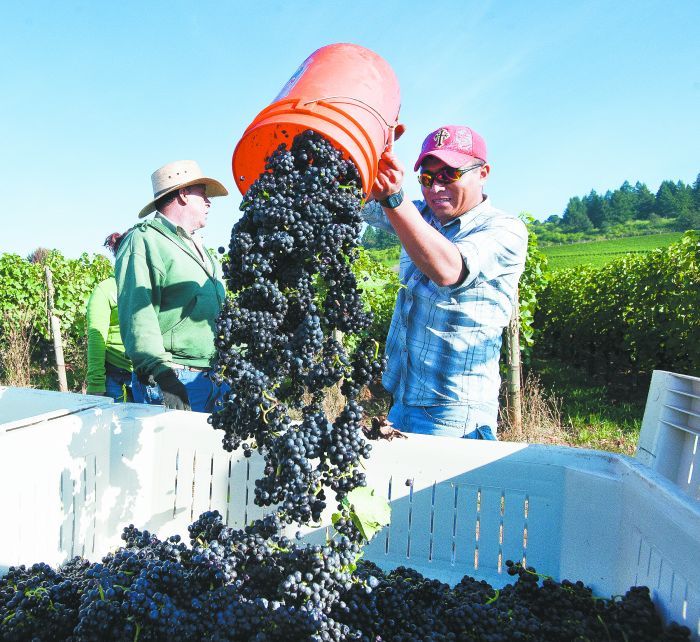October weather brings big-time benefits for vintage 2013

By Karl Klooster
Reprinted from November 2013 Oregon Wine Press
Mother Nature lavished love on Oregon wine country for most of the 2013 growing season. But something upsetting in late September caused her to unleash a tantrum in the form of a Western Pacific typhoon. Then, inexplicably but magnanimously, she followed that bad behavior by rewarding the entire Pacific Northwest with one of the warmest and driest Octobers on record. Talk about Indian Summer.
Over the course of these season-ending uncertainties, winegrowers, particularly in the Willamette and related northwestern Oregon valleys, faced challenging decisions about when to pick. Those who guessed right came out way ahead; those who didn’t endured varying degrees of difficulty. Fortunately, very few suffered heavy crop losses.
Veteran vineyard manager and consultant Buddy Beck shared some instant observations about the 2013 vintage as it draws to a close. Beck, who has worked in the industry locally for 26 years, started his own company, Advanced Vineyard Systems, in 1999. He now oversees 55 vineyard sites, totaling more than 350 acres.
“I would say before the big storm, we had about 25 percent of our grapes picked. Those early ripening sites came in right on the money. But we decided to wait on the rest to boost flavors. The rains caused a drop in brix of 2 to 3 percent because of dilution, but some had already been gained back when we resumed picking. I’d say we will average about 22 to 22.5 brix (or alcohols in the low 13 percent range),” Beck said.
“But flavors are more important than sugar levels and they are beautiful. After dropping some botrytis-affected and split clusters in the vineyard and catching the rest on the sorting line, the fruit is absolutely gorgeous,” he continued. “All the winemakers I’ve talked to are very happy. And I’m confident that with their skills, they will make some outstanding wines from the 2013 harvest.”
Beck’s confidence about quality was mirrored by growers large and small. The degree of storm damage suffered must be evaluated on a case-by-case basis, but Beck felt it would amount to no more than 5 to 10 percent overall.
Although there will be some loss of quantity owing to botrytis rot and skin splitting, the valley’s mostly Pinot Noir vineyards have come through with flying colors. Since this year’s harvest started two to three weeks early, the entire crop, including the latest ripening varieties, will benefit from warmer temperatures compared to normal throughout their maturation.
Laurent Montalieu of NW Wine Company, who has also been here many times before, decided to wait out the rains on some 60 percent of the crop from the 625 acres of vineyards he either owns or manages. After final picking on Oct. 23, Montalieu exclaimed, “This was an incredible ending to a challenging harvest. We had very little loss in splitting and rot that had to be sorted out.
“But the clean fruit that has come through at the last is beautiful. Brix readings of 24.5 to 25.5 were the average with 100 percent physiological ripening. I’m very happy,” Montalieu said.
He noted that a well above average quantity of Riesling has been allowed to hang in their 40-year-old Hyland Vineyard to gain the full benefit of botrytis.
“The grapes are looking so good, I am shooting to make beerenauslese wines this year,” Montalieu declared. “It will be expensive, but worth it.”
He was referring to the ultra-late harvest German wines produced only in the best years from fruit affected by botrytis cinerea. Individual berries are handpicked for their high sugar concentration and lush, honey-like flavors imparted by the fungus universally referred to as “noble rot.”
Whether in German, “edelfäule,” French, “pourriture noble,” or English, noble rot can result in an intensely concentrated, delightful savoring and sipping taste experience.
Across the Willamette Valley, from end to end, growers reported all their fruit, except for the few late harvest exceptions, was in the winery by the third week in October.
The story in Southern Oregon was even sunnier. Problems as a result of the tumultuous end of Typhoon Pabuk were minor despite the short spate of heavy rainfall giving the Rogue Valley its second-wettest-ever September. In fact, for Southern Oregon growers, this season turned out close to ideal. The extended warm weather afforded them the option to choose precisely when each site reached optimum ripeness.
On Oct. 21, Randy Gold of Pacific Crest Vineyards was quoted in the Medford Mail Tribune as saying, “Most of our fruit came off the vines early, before the rains hit. With the later-ripening fruit, the rains slowed down the development of sugar, the ‘brix,’ and the subsequent cooler, dry weather allowed the flavors to mature.
“We’re getting some serious hang time, improving flavors,” Gold said. “Growers with fruit hanging now all over this region have smiles on their faces.”
Update: Dec. 20, 2013: With only a couple months’ additional perspective, there appears to be a high likelihood that some exceptional wines will emerge from the 2013 vintage, particularly from wineries where fruit was picked after the rains. But Southern Oregon was not affected as much as the north to begin with, so they are looking at little loss and the prospect of very nicely balanced wines.
Perhaps the most widespread comment to date is how everything displays much understated excellence — acids, pH, tannins, flavor extraction. No big hills or valleys. Smooth sailing.







